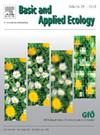居民对城市绿地文化生态系统服务的感知:韩国和德国的比较研究
IF 3.5
2区 环境科学与生态学
Q2 ECOLOGY
引用次数: 0
摘要
了解公众需求对于有效管理和规划城市绿地(UGS)至关重要。UGS提供促进人类福祉的文化生态系统服务(CES)。然而,消费电子学的测量具有挑战性,并且在不同的文化中存在差异,这限制了跨文化研究。本研究通过基于地图的PPGIS问卷调查了韩国水原和德国卡尔斯鲁厄UGS的公众对CES的看法。受访者是两个城市的城市居民,在2023年7月至9月期间通过在线宣传、当地帖子和滚雪球抽样的方式招募。卡尔斯鲁厄居民比水原居民更频繁地访问UGS,在新冠疫情前后的时间也更长。大多数水原居民喜欢最近的绿地,而卡尔斯鲁厄居民则喜欢离家较远的UGS。在水原,较高的收入与较低的生物多样性重要性评价有关。年龄和性别影响了两个城市对生物多样性重要性的评价。在这两个城市,在COVID-19之后,年轻人比老年人更频繁地访问UGS。在卡尔斯鲁厄,女性访问UGS的频率高于男性,而在水原,男性访问UGS的频率更高。然而,卡尔斯鲁厄的女性受访者在UGS中花费的时间比男性多,而水原的差异没有统计学意义。受教育程度只在水原显著,在新冠疫情后,受过大学教育的人在UGS的时间比没有受过大学教育的人长。这些发现反映了文化和社会人口因素如何塑造人与自然的相互作用,支持了诸如亲生命假说、社会生态学和环境心理学等理论观点。将这些跨学科的见解整合到UGS规划中,有助于创造包容性、文化响应性和生态意义的城市环境。本文章由计算机程序翻译,如有差异,请以英文原文为准。
Residents’ perceptions of cultural ecosystem services from urban green spaces: A comparative study of Korea and Germany
Understanding public needs is crucial for effective management and planning of urban green spaces (UGS). UGS offer cultural ecosystem services (CES) that enhance human wellbeing. However, CES are challenging to measure, and vary across cultures, limiting cross-cultural research. This study examines public perceptions of CES from UGS in Suwon, Korea, and Karlsruhe, Germany, through a map-based PPGIS questionnaire. Respondents were urban residents in both cities, recruited through a combination of online outreach, local postings, and snowball sampling between July and September 2023. Karlsruhe residents visited UGS more frequently and spent more time there both before and after COVID-19 than Suwon residents. Most Suwon residents favored the nearest green spaces, while Karlsruhe residents preferred UGS farther from their homes. In Suwon, higher income was linked to a lower evaluation of biodiversity importance. Age and gender influenced the evaluation of biodiversity importance in both cities. Younger people visited UGS more often than older people after COVID-19 in both cities. In Karlsruhe, female respondents visited UGS more frequently than male respondents, whereas in Suwon, male showed a higher frequency. However, female respondents in Karlsruhe spent more time in UGS than males, while there was no statistically significant difference in Suwon. Education level was significant only in Suwon, where individuals with university education spent more time in UGS after COVID-19 than those without. These findings reflect how cultural and socio-demographic factors shape human-nature interactions, supporting theoretical perspectives such as the biophilia hypothesis, social ecology, and environmental psychology. Integrating these interdisciplinary insights into UGS planning can help create inclusive, culturally responsive, and ecologically meaningful urban environments.
求助全文
通过发布文献求助,成功后即可免费获取论文全文。
去求助
来源期刊

Basic and Applied Ecology
环境科学-生态学
CiteScore
6.90
自引率
5.30%
发文量
103
审稿时长
10.6 weeks
期刊介绍:
Basic and Applied Ecology provides a forum in which significant advances and ideas can be rapidly communicated to a wide audience. Basic and Applied Ecology publishes original contributions, perspectives and reviews from all areas of basic and applied ecology. Ecologists from all countries are invited to publish ecological research of international interest in its pages. There is no bias with regard to taxon or geographical area.
 求助内容:
求助内容: 应助结果提醒方式:
应助结果提醒方式:


